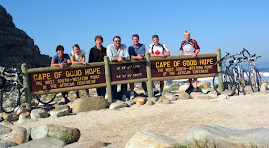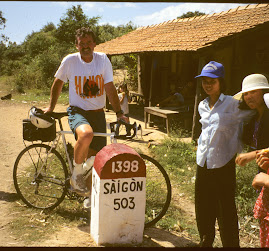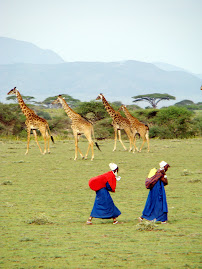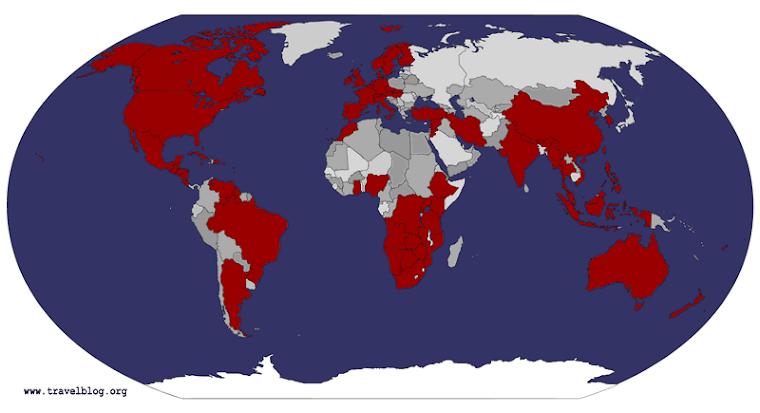

VIETNAM
-a cycling odyssey
I'm not a newcomer to cycling, but as I flew into Hanoi airport to start a 16-day, 1,900 kilometre ride to Ho Chi Minh City, it was with a certain amount of apprehension.
After all, even though the war was over, what if I ran into a soldier from "the other side who hadn't been told," or I got blown up by a land mine while venturing into the bushes for relief.
I had signed up with 50 others, average age 42, and most of them American, to do this trip, the first such trip allowed by the Vietnamese. Some signed up for the cycling, some for the unique experience of being in Vietnam, and seven veterans of the war returned with their own personal reasons.
Most people, in the western world, view Vietnam as an impoverished country permanently in a state of war whether it be with the french, Americans, Chinese or Cambodians. Indeed to older people in North America, their image of it is as a sinister country, and one that they remember back in the 60's being pummelled by bombs in an effort to avoid the so-called "domino-theory", the collapse of the whole of Indochina into communism.
However, contrary to most expectations, while this country is poor, and some of it desperately, it is nonetheless the type of country that travellers dream about; it has unique culture, friendly people, safe streets, few cars and beautiful vistas.
It is also an honest country, a fact that was demonstrated to us when a member of our group lost his wallet in Da Nang. It was returned to him seven days later, 800 kilometres away, with its contents, the equivalent of a year's income for most Vietnamese, totally intact.
The ideal way to experience this country is from the seat of a 15-speed bicycle.
We started in Hanoi where we visited Ho Chi Minh, lying in state in his mausoleum. "Uncle Ho" is revered in this country, and effigies of him are everywhere. He may have been the father of the country, but he wasn't the father of any children and never married. His final resting place is a site of pilgrimage, where he lies in state in a huge mausoleum surrounded by erect guards who make sure that you are properly dressed, and you don't talk. He spends most of the year there except when his body is sent to Moscow for "remedial maintenance."
We passed by the Hanoi Hilton, nickname of the prison where downed US pilots were incarcerated. It is a forbidding structure and not one that the Vietnamese like to acknowledge to visitors. It will in fact be torn down later this year and Singapore Airlines will build a five-star hotel on the site.
After we left Hanoi, we continued south, moving through both industrial towns and wide-open countryside, at a daily pace of 150m kilometres.
All along, people waved at us and shouted the same questions;
"Where you from?"
"How old are you?"
"What's your 'yob'?"
It took three days of hearing these same questions from different people in different towns before we caught on that this was no coincidence. Indeed, we found out that broadcast wake-up calls which blare from Tannoys at 4.45 a.m. each morning, advised the locals in each community of our impending passage through.
Their interest in us was keen and genuine, and their curiosity about us increased as we got further away from the major towns. In some remote villages, particularly in the North, they liked to examine us in more detail, by pulling the hair on our arms and calculating the widths of our calves. Each time we stopped, we attracted a crowd of as many as 100 fascinated people.
In a country where 70 million people own 20 million cycles, there are repair shops everywhere. A flat can be fixed for ten cents, a pump-up can be had for two.
And whenever you get a flat, an inevitability on Highway 1, you attract an audience of mechanics anxious for the opportunity to check out our state-of-the-art cycles, with their many gears, hand grips, fancy paints and high pressure tires. This attention can be quite intimidating, and even though you may have fixed 100 flats in your career, you inevitably decide to let a local do it for you, and save the possible embarrassment.
While there may be millions of bicycles in Vietnam, there is very little variety. Most are domestically produced single-speed jobs that sell for $25 and carry a proper socialist name like "Corporate", while the more luxurious "Pioneer" comes from China with up to three speeds and a $100 price tag. Even the Chinese models have a reputation for inferiority, but I met two Australians who had purchases tow of them in China, and were cycling through Vietnam and then into Cambodia on them.
We crossed the DMZ where 5,000 citizens have been killed or injured by land mines left over from the war, and into country that was the scene of some of the bloodiest battles of the war. And the grim reminders of that undeclared war that killed four million civilians are everywhere; battle-scarred churches, damaged bridges, and limbless villagers.
We cycled down the coastline, with beaches as beautiful as any I have seen in the Caribbean, and dine on lobster and crayfish at prices that only our grandparents can dream about.
We passed through the beautiful imperial city of Hue, once the cultural centre of Vietnam, a title it still claims, and the capital of Vietnam from 1802 to 1945.
It was also the site of bloody battles during the war, including some of the fiercest battles of the Tet offensive which left 10,000 soldiers and civilians dead. The Forbidden Purple City, located in the Citadel, was once home to the emperors, and was modelled after the Forbidden City in Beijing. It was also a heavy casualty of the war, and the government has chosen to leave it in its war-damaged state rather than try to memorialise it.
After Hue, we went to Da Nang, equidistant from Hanoi and Saigon, and the site of the first US combat troop landings. It is a dirty city and devoid of any character, though its one redeeming quality is its Museum of Cham Art, which houses probably the finest collection of Cham sculpture in all of Southeast Asia.
After Da Nang is the old trading port of Hoi An, an anagram of the capital. Its distinction is its layout. Three main streets back on to three canals, so goods could be loaded directly on to boats from their backyards. The average age of each building is 200 years, with the oldest being more than 1,000. It also has a number of beautiful Japanese/Chinese pagodas and bridges that are more than 500 years old and serve as memorials to imperial Vietnam.
We visited China Beach, a gorgeous and isolated white sand beach, and overlooking it, the incredible Marble Mountain complex. The Viet Cong maintained a secret field hospital here, while observing the activities of American soldiers on R & R down on the beach below.
Our hotels and meals were all covered as part of our package, but we made frequent stops at roadside cafes along the way for tea, or a 33, a local beer better known as Ba Ba. Like everything else in the country, it is ridiculously inexpensive, about 6,000 dong, and with an exchange rate of 10,000 dong to one U.S. dollar, your dong goes a long way. However, the flipside of this is that the currency just has too may zeros. When you exchange $50 U.S., you get a wad of paper back the size of a brick.
In Quang Ngai, we left the highway and cycled the twelve kilometres or so to Son My, a collection of four hamlets, one of which was known as My Lai, the site of a mass killing of more than 500 women, children and old people by the Americans, who believed that the villagers were giving support to the Viet Cong. Today there is a memorial to the victims, as well as a museum.
Around it, among the rice paddies, are the foundations of each home, and above them, gravestones that list the names and ages of the members of each family killed.
From Quang Ngai we travelled to Qui Nhon and then on to Nha Trang. As we passed through each village, and by each rice paddy, we seized on every opportunity we could to join the people in their work, and in their play. Whether it was taking off our shoes to help them plant rice, or plowing a furrow behind a pair of water buffalo, or picking up a cue on a roadside billiards table, we were anxious to participate in every aspect of the lives of these fascinating people.
Everywhere we went, the people waved and called out the familiar three questions. They all assumed I was American, but asked the question just the same. They seemed surprised when I answered, CANADA. And even when I wore shirts with hockey players or Canada geese displayed underneath huge letters that spelled C-A-N-A-D-A they still asked. Incidentally, Canada is the only large country that is the same in the Vietnamese language; yet they still asked!
If we had any regrets, it was only that we couldn't communicate with the people in their own language, only return their sincere waves and smiles. We would have liked to be able to say "hello" in Vietnamese, but it is age and gender specific, so we would have run the risk of accidentally insulting or overly flattering everyone.
At times the attention got a little much, and we had to concentrate on maintaining a good attitude. People, particularly children and youths, liked to ride closely with us, within inches of our front, our side and our back, shouting their obligatory questions, and just trying to be friendly. However, any mementary lapse in concentration would result in a painful and inevitable fall.
In Nha Trang we relaxed on what must be the most beautiful municipal beach in the world, where most of us got a pedicure and manicure for the equivalent of $2. For an additional $2, some of us enjoyed a massage on the beach listening to the ocean sounds, a perfect cure for anyone suffering from insomnia. And while many of us suffered at one time or another from one ailment or another, insomnia was not one of them. Indeed we seemed to spend our days just biking sleeping and eating!
We also visited a "bike wash" where our cycles had 700 kms of grime scrubbed off and then polished to a sheen, for the equivalent of fifty cents. When they were finished, our bikes looked like they had just come off the assembly line.
From Nha Trang we continued on down the coastline and past beaches that will likely become fancy resorts in a few years. We were pedalling in 80 degree weather, so it felt great when we finally turned inland at Phan Rang with its Cham temples, and headed 1,600 metres up to Dalat.
This is a beautiful city, once known as Le Petite Paris, and the playground of the French and South Vietnamese who went there on weekends to escape the impossible humid temperatures of the Saigon summers. Dalat is famous for its coffee and vegetables, particularly avocados that they seem to put into everything; avocado tea, avocado soap, avocado ice cream etc.
From Dalat we headed south-east to Ho Chi Minh City, through the mountains and the mulberry and rubber plantations. We stopped our bikes at every "photo-op" as curious of those with their conical hats who toiled in the fields planting rice, as they were of us begging to take their pictures. And as we got closer to the largest city in the country, and rejoined Highway 1, we felt like we were leaving a time warp. The traffic increased, and we started hearing and seeing new sounds and sights; American music from the '60s, and tailored, stylish clothing.
And when we finally reached Ho Chi Minh City, we realized we had left one experience, and entered quite another.
For this was a city that is quite different from the rest of the country.
With a population of over five million, it is spread over 2,000 square kilometres, stretching from the South China Sea almost to the Cambodian border. It has that vibrant energy, so common in the Vietnamese. While the peasants in the rest of the country are toiling from sunup to sundown in the rice paddies, their urban relatives are working just as hard pursuing their commercial activities. And Saigon, as most of its population still refers to it as, is one commercial ambush.
We saw very little evidence of "Uncle Ho's" ideals being practiced here. Instead we saw ribald capitalism just waiting for the end to the embargo. On every corner, screaming touts shoved their wares in our faces.
Everyone wanted to "do a deal", whether it was for T-shirts, "three dollars each", "OK, five for five bucks" to a cyclo ride around town, "regular price five dollars, but for you Canadian special 50 cents."
Incidentally, a number of the cyclo drivers are former officers of the South Vietnamese Army, or opponents of the Communists, who were ostracized by them after reunification. Not only they, but their families, are denied basic privileges such as residency permits, which are necessary should one want to work for someone, own a home or business, attend school etc.
There are a number of things worth seeing in Ho Chi Minh City.
The most popular attraction amongst western visitors, is the War Crimes Exhibition. It includes a collection of U.S. vehicles, weapons, a French guillotine, and a number of photographs that illustrate some of the nastiest parts of the war.
Reunification Hall, formerly the Presidential Palace, was seen by millions of television viewers around the world, as Communist tanks came crashing through the iron gates in 1975 to establish Communism as the government of the country. The Palace has been left pretty much as it was that day 19 years ago.
Another building that is familiar to those same television viewers is the former U.S. embassy, from whose roof desperate citizens who had cooperated with the Americans, and who claimed they had been promised safe passage by them, tried to escape on to rooftop helicopters.
We spent three days in Ho Chi Minh City, and felt that this could well become the economic powerhouse in Southeast Asia. The Government has instituted reforms such as private enterprise, elimination of many state subsidies, and the liberalization of foreign investment. However it has also rejected political reforms, insisting it will continue with its single-party system.
Its role model at the moment seems to be China, which is also trying to balance its old single party system of government with economic liberalization. Time will tell if they have picked the right country to emulate.
But Vietnam is not going to be an orphan for much longer. It has a fierce sense of nationalistic pride, coupled with a strong work ethic that will propel it to the top economic ranks of its Indochinese peers. How long that will take, no one knows, but happen it will.
We left Vietnam with an almost universal sense of sadness, but also one of gratefulness at having been given the chance to view this country at the end of its time warp. All of us have had varying degrees of difficulty in reverting back to our pre-Vietnam lifestyles.
We all feel that we have been part of a very unique experience that not only us participants can fully comprehend. Two months after our return home, we are still calling each other on a regular basis, exchanging photographs and news of former comrade riders. Some are simply despondent while others have quit their jobs!
I am glad I saw Vietnam when I did. President Clinton has new lifted his country's economic embargo, so maybe I saw it just in time.
And as one of my fellow travellers so succinctly put it as we left Hanoi at the start of our journey; "This is one of the last times you'll be able to walk into a society that still has the charm and innocence that existed 50 years ago."
So enthused were we with our experience, that we all got in touch with our trip organizer, an Oregon politician in his former life, and pleaded with him to arrange a follow-up to this, his first such venture.
Most of us have signed up for his second trip; Saigon to Singapore, via Cambodia, Thailand and Malaysia.
I can't wait!




No comments:
Post a Comment